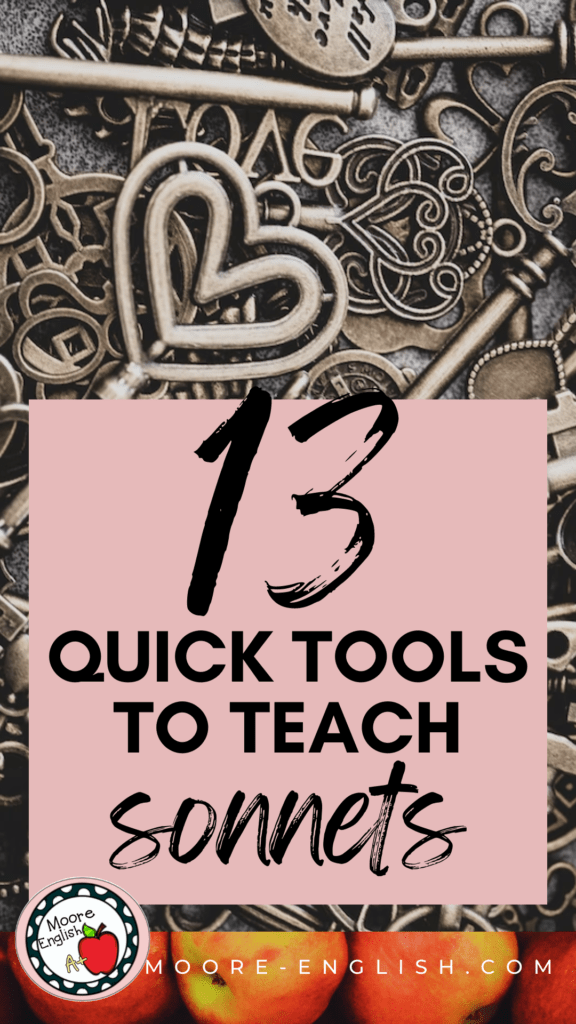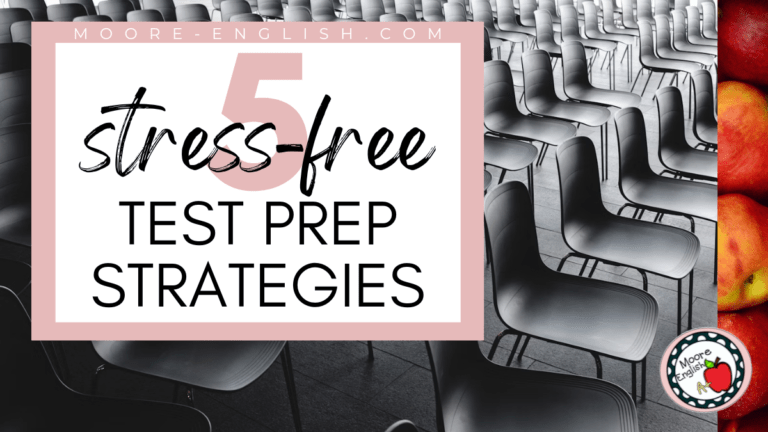CCSS.ELA.R.5 asks teachers to help students analyze the structure of a text. This can be a tricky task to accomplish. Not everyone has time to see the frames in To Kill a Mockingbird and The Great Gatsby play out. Additionally, at the secondary level, there’s a need to push students beyond flashback, foreshadowing, and plot structure.
For this reason, poetry is a great way to focus on structure. Poems are short, so students can focus on them for one or two days. In a week, students can read several poems and compare structures. In particular, the simplicity of sonnets makes them a perfect vehicle for teaching structure. Today, I want to share 13 quick tools teachers can use to teach sonnets.
Begin with English Sonnets
For most students, sonnets are a new concept. They may have heard the word “sonnets,” but they rarely have any concept of the definition. For this reason, I start students with the English or Shakespearean because it is the most concrete option. In fact, I have a high-engagement inquiry-based lesson plan for introducing English sonnets. Check it out here.
In addition to my inquiry-based lesson plan, these four resources are a perfect way to introduce English sonnets.
- First, the Crash Course episode about Shakespearean sonnets is a perfect way to begin. In a short time, John Green runs students through the basic structure and even works through Sonnets 16, 118, and 130. This is one of my favorite instructional videos for a reason! Watch it here.
- Once students have an idea of what to look for in English sonnets, it’s time to look at some examples beyond Shakespeare. “No Second Troy” by William Butler Yeats and “Helen of Troy” by Ella Wheeler Wilcox are perfect examples. As an advantage, the shared allusion in these texts makes them perfect companions! This is a great opportunity to work on structure and synthesis thinking.
- Finally, it’s always fun to challenge students to write their own sonnets! With this free, editable rubric, teachers can easily help students practice writing their own sonnets. As a fun follow up, teachers can plan a poetry slam where students can share their work!
Approaching Italian Sonnets
I have to admit when I approach Italian sonnets with students, I often skip over Petrarch. Instead, I focus more on helping students see the variations in Italian sonnets and the way that poets play with rhyme and structure in this more flexible sonnet form. Here are some great examples of Italian sonnets you can share with students:
- First, “The New Colossus” by Emma Lazarus is very formal and traditional in its structure. As a bonus, students don’t usually find this poem intimidating because of its familiarity and low-stress subject matter. Read it here.
- Second, “The World is too Much with Us” by William Wordsworth is a classic. The turn is clear, so this is a great piece for helping students appreciate structure. Read it here.
- Third, “Before a Painting” by James Weldon Johnson also has strong traditional elements. The imagery is beautiful, and it’s a good text to follow up on Wordsworth’s work. Read it here.
- Sonnets are often thought of as love poems. “I, being born a woman and distressed” and “Time does not bring relief; you all have lied” by Edna St. Vincent Millay play with that idea. These are two great poems to show students the Modern interpretation of sonnet structure. Similarly, these are two great pieces of text for applying feminist criticism. Read them here.
- Finally, “Anthem for a Doomed Youth” by Wilfred Owen is such a devastating poem. It’s a piece of literature everyone should read. It’s also an incredible reinterpretation of the sonnet-as-love-poem. Like St. Vincent Millay’s work, this poem shows how traditional forms can be updated to serve Modern audiences. Read it here.
Evaluating Variations
Once students have a handle on sonnet forms, teachers can expand their understanding of structure by introducing variations on the sonnet form. By first understanding sonnet form, students can understand the power of varying, violating, or writing beyond that form. Here are three classroom-friendly sonnet variations:
- First, “Summer Morn in New Hampshire” by Claude McKay is a sonnet without the closing couplet. Plus, McKay made significant revisions to the poem, which allows students to evaluate how and why he made those changes and how structural changes can affect an author’s purpose. Read it here.
- Additionally, “The Lake Isle of Innisfree” by William Butler Yeats shares a lot of similar imagery with McKay’s poem. However, Yeats does not subscribe to the metrical limitations of sonnet form, nor is he interested in many of the other features. In this case, students may even be able to have a debate about whether this poem constitutes a sonnet at all. Read it here.
- Finally, my favorite poet is Gerard Manley Hopkins, and my favorite poem is “Spring and Fall: To a Young Child,” which glances as sonnet form. In this poem, Hopkins gives readers an extra line and has no interest in the rhyme scheme of a sonnet. Even if this poem doesn’t fully qualify as a sonnet, it is an excellent poem for teaching structure. (Plus, it’s my absolute favorite, and I couldn’t skip it.) Read it here.
What other sonnets should we add to this list?

















